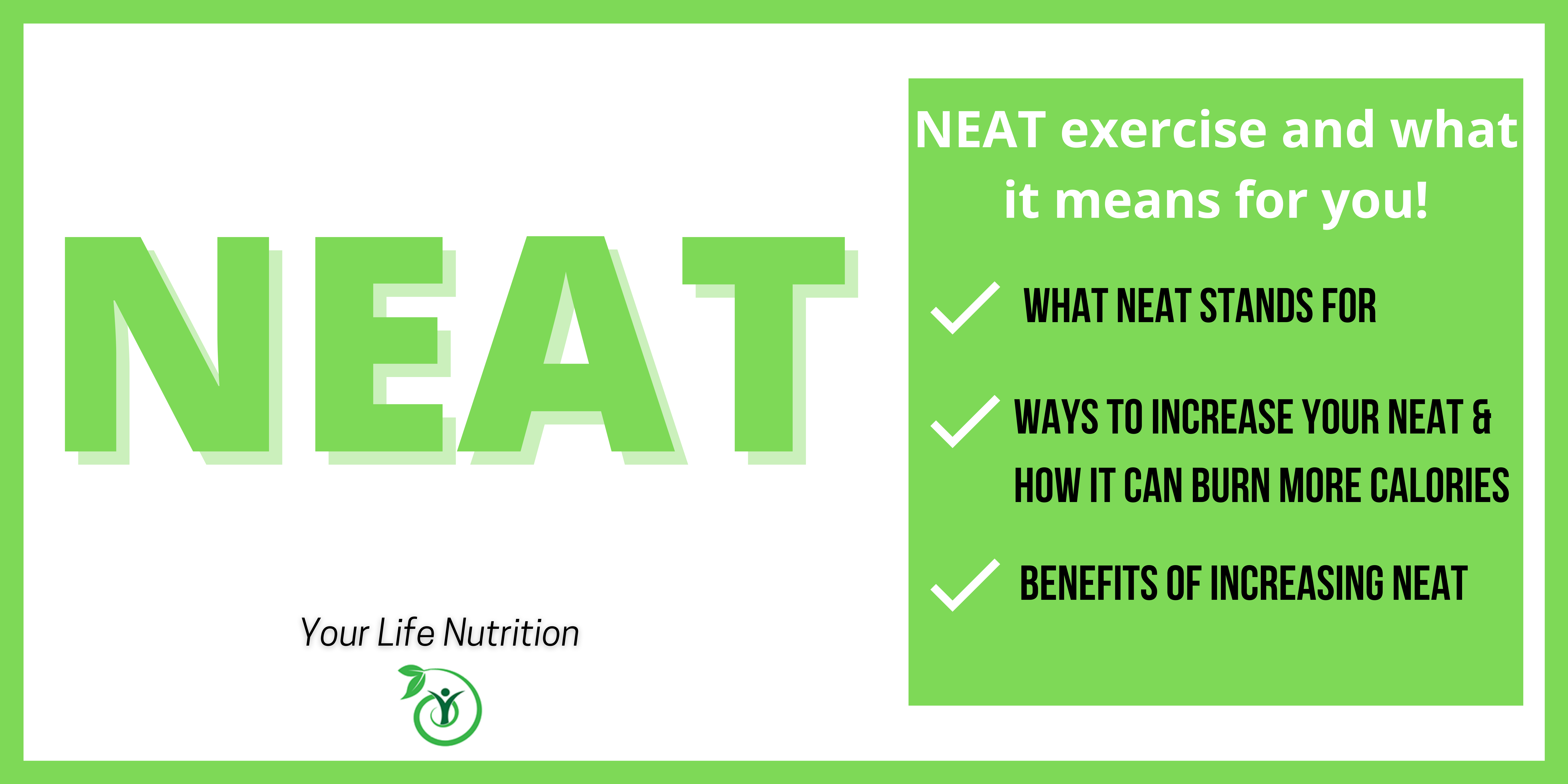What is NEAT exercise?
NEAT stands for Non-Exercise Activity Thermogenesis. It is energy expended for everything we do that is not sleeping, eating or sports-like exercise. (1) Basically all non-exercise movements which can range from energy expended such as walking to work, performing yard work, or typing on a laptop. (1)
How does NEAT work?
NEAT includes a series of continuous and vital movements that do not involve moderate- to vigorous-intensity exercise. These additive activities account for significant thermogenesis and energy consumption. (2)
By just doing simple daily manual task activities, NEAT can be enhanced throughout the workday and at home. These activities should be encouraged in childhood and continued during adulthood. (2)
Does NEAT count as exercise?
Yes! Some NEAT activities can be considered high impact. These activities include walking at 1 mile an hour, which is considered “shopping speed”, and doubles the metabolic rate. Walking at 2 miles an hour, which is equivalent to walking to a meeting, increases their metabolic rate by about 150 to 200 calories per hour depending on size. Rushed walking such as running to an airport gate can triple one’s metabolic rate above basal or normal. (3)
Is NEAT better than exercise?
While there is no definite answer for this, exercising for 30 or 60 minutes once out of the day is important for improving overall health and wellness, contributing to a stronger, more efficient heart, and reducing risks of heart disease and diabetes, stronger muscles and thicker bones, reduced cholesterol levels, and improved mental health. Using exercise and NEAT together outweighs exercise alone and especially for weight loss. (4) NEAT is how we can continue to boost our metabolism throughout the entire day.
Why is NEAT important?
Humans are designed to walk and stay active. Over the course of 200 years we have been on a decline and heading towards a more sedentary lifestyle by being compressed into chairs in our work, education and home environments which lowers our NEAT and compromises the health of those individuals. (3)
Low NEAT (having a sedentary lifestyle) is associated with lower daily energy expenditure than a person of similar size with high NEAT. (3) During a period of over eating, a person who does not increase NEAT is likely to gain greater adipose tissue than a person with high-NEAT and people with obesity are more prone to low NEAT and sedentariness. (3)
NEAT decreases cardiovascular disease mortality and improves metabolic parameters. NEAT has good long-term adherence, with positive impact. (2)
Here are some NEAT ways to increase your energy expenditure!
- Stand more. Start by attempting to stand or move about for 5 to 10-minute increments while you complete various daily activities.
- Wash your car by hand.
- Pace the sidelines at your kids’ athletic games.
- Carry your groceries in a basket instead of pushing a cart.
- Walk briskly through the mall.
- Take the long way to the lunch room or bathroom at the office.
- Walk to a co-worker’s desk instead of emailing or calling them.
- Pace/go on a walk while talking on the phone. (4)
- Hand wash clothes or dishes (2)
- Walking to work (2)
- Climbing stairs (2)
- Park further away from the grocery store
- Walk to the grocery store or to other errands
Benefits of increasing NEAT
- Multiple amounts of low level activity may help to expend 2000 kcals or more (3)
- Reduces sedentary lifestyle (3)
- Lowers the risk for atherosclerosis which is the buildup of fats, cholesterol and other substances in and on your artery walls. This buildup is called plaque. The plaque can cause your arteries to narrow, blocking blood flow. (2)
- Those individuals with Type-2 diabetes improved their insulin sensitivity, high-density lipoprotein cholesterol level (HDL) and blood pressure (2)
- Lowers the long-term risk for cardiovascular disease events and mortality (2)
The NEAT Takeaways:
Through the years our society has become more sedentary. Low Non-Exercise Activity Thermogenesis (NEAT) may increase risks of obesity and diseases. Incorporating more NEAT exercises such as walking, doing household chores, and more can help keep physical activity levels up, increases NEAT and add up to many benefits such as an increase in overall energy, weight loss, and reducing risks for diseases and mortality.
What type of NEAT will you incorporate into your routine? Let us know in the comments below!
Blog post written and created by Your Life Nutrition Intern, Christopher Milhoan, Senior Dietetics Major at University of Akron
- Levine JA. Non-exercise activity thermogenesis (NEAT). Best Pract Res Clin Endocrinol Metab. 2002;16(4):679-702. doi:10.1053/beem.2002.0227
- Villablanca PA, Alegria JR, Mookadam F, Holmes DR, Wright RS, Levine JA. Nonexercise activity THERMOGENESIS in Obesity Management. Mayo Clinic Proceedings. 2015;90(4):509-519. doi:10.1016/j.mayocp.2015.02.001
- Levine J.A., McCrady-Spitzer S.K. (2018) Non-Exercise Activity Thermogenesis (NEAT) and Adiposity. In: Leitzmann M., Jochem C., Schmid D. (eds) Sedentary Behaviour Epidemiology. Springer Series on Epidemiology and Public Health. Springer, Cham. https://doi.org/10.1007/978-3-319-61552-3_7
- Comana F. A neat approach to weight loss and Exercise (UPDATED 2020). NASM. https://blog.nasm.org/exercise-programming/neat-approach-weight-loss. Published 2020. Accessed August 31, 2021.





